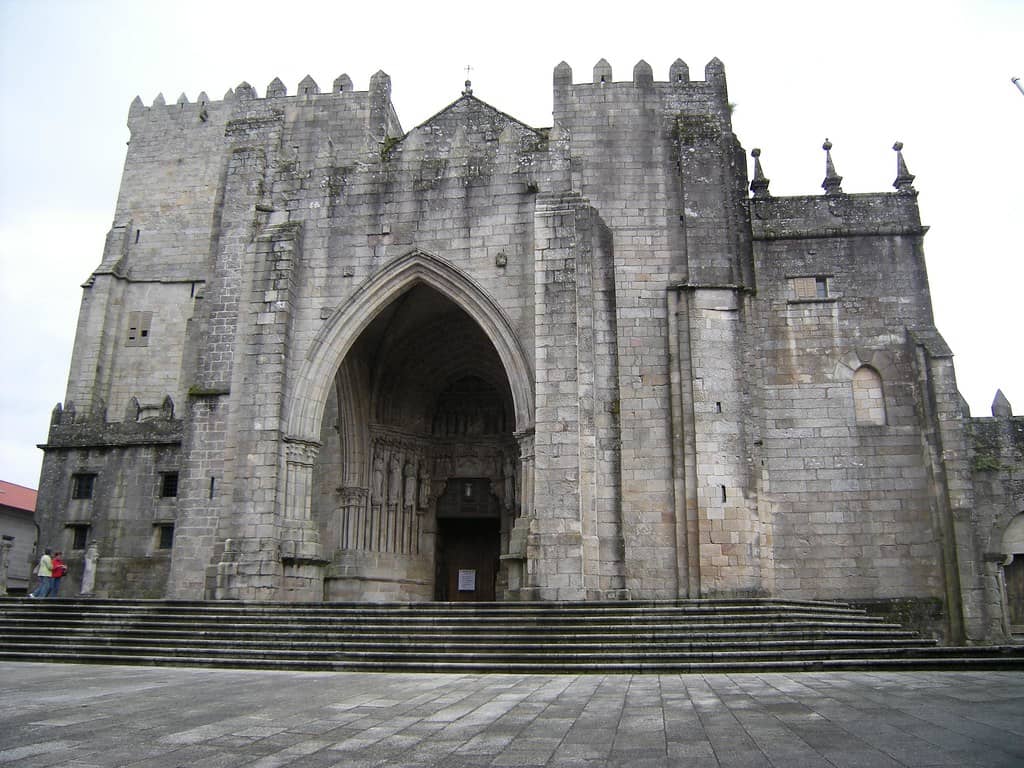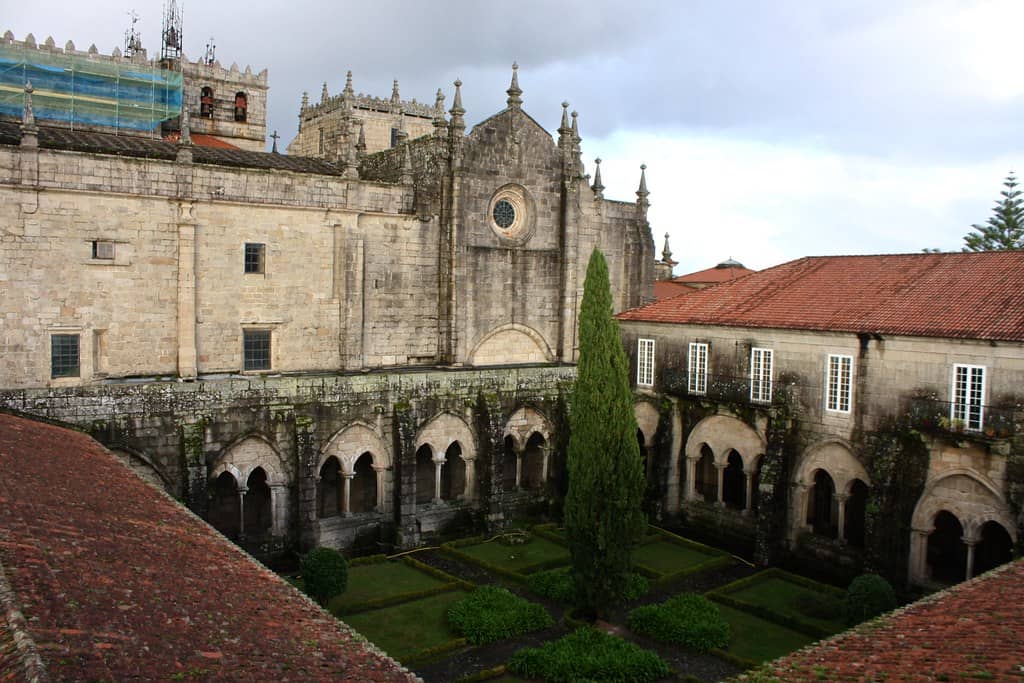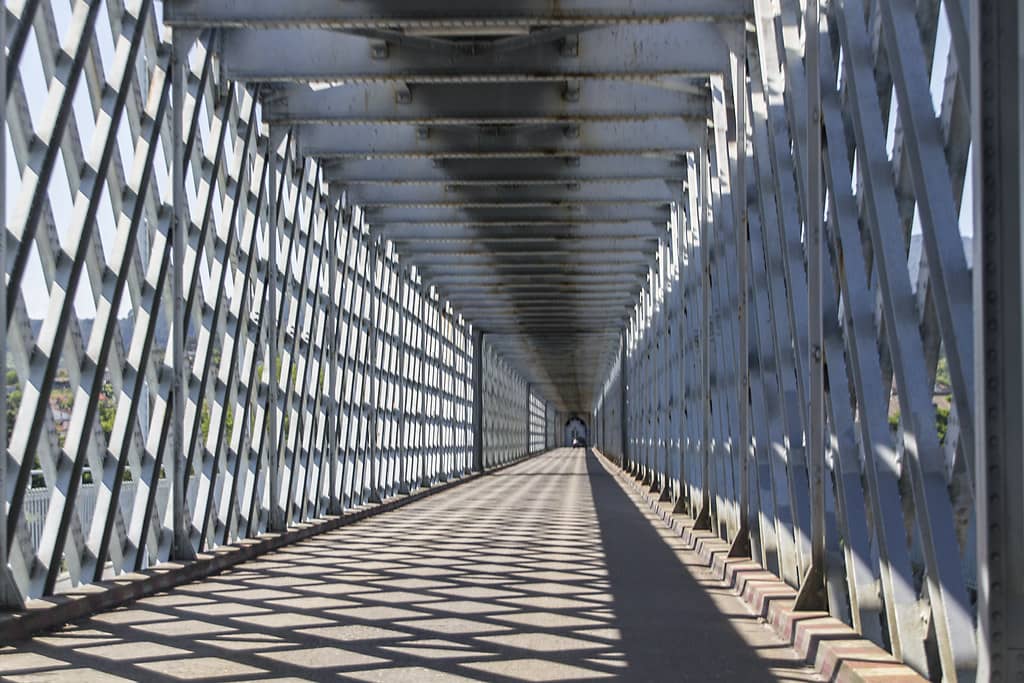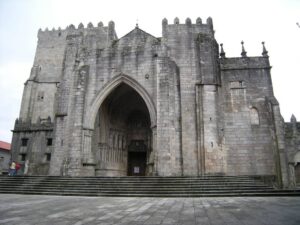
Strategically located between Galicia and Portugal, Tui is much more than a border town. It is a meeting point of cultures, a historic nucleus full of symbolism, and for many, the beginning of an unforgettable journey: the Camino de Santiago.
Its imposing Catedral de Santa María, visible from the other side of the Miño River, is not only remarkable for its architecture but also for its spiritual significance to pilgrims. Starting the pilgrimage here means beginning from a place filled with history, mysticism, and beauty. It is not a casual choice: it is a statement of intent.
Índice de contenidos
- 1 The History of the Cathedral of Santa María de Tui
- 2 What to See in the Cathedral of Tui: A Tour of its Interior and Surroundings
- 3 Why Start the Camino from Tui?
- 4 Why is the Camino Portugués from Tui such a Special Choice?
- 5 Tui, a city with much to offer
- 6 The excitement of the first step
- 7 Key stages from Tui to Santiago
- 8 Practical tips for the pilgrim starting in Tui
The History of the Cathedral of Santa María de Tui

The cathedral of Tui began construction in the 12th century on the site of an ancient Visigothic temple, and its consecration took place in 1225. Its construction spanned more than a century, which explains the blend of architectural styles, with a Romanesque base and a clear evolution towards Gothic.
During the Middle Ages, this town was one of the most important religious and administrative centres in Galicia. The episcopal seat of southern Galicia, with jurisdiction over vast territories, made the city a key point for both political control and the spiritual care of pilgrims.
The temple not only served as a place of worship but also as a fortress. In fact, its western facade has a military appearance, with crenellated towers that defended the city against attacks from Portugal. Inside, synods, consecrations, noble weddings, and historically significant events have been celebrated.
What to See in the Cathedral of Tui: A Tour of its Interior and Surroundings

The monumental complex of the Cathedral of Tui is one of the most valuable in Galicia. Upon entering, visitors are greeted by a basilical plan with three naves and ribbed vaults. The contrast between Romanesque austerity and Gothic details creates a unique atmosphere.
Among the most notable features are:
- The baroque main altarpiece, a work of great ornamental richness.
- The Chapel of San Telmo, the patron saint of the city and a figure venerated by sailors and pilgrims.
- The Gothic cloister, unique in Galicia, allowing visitors to stroll between pointed arches and centuries-old silence.
- The Catedral Museum, which displays monstrances, chalices, medieval images, and historical documents.
It is also worth observing the carved wooden choir, the 17th-century stalls, and the baroque organ, which is still played on special occasions.
Opening Hours, Fees, and How to Plan Your Visit
The Cathedral is open every day, except on specific dates due to religious events. The usual opening hours are as follows:
- April to October: from 10:00 to 20:00.
- November to March: from 10:00 to 18:00.
General admission costs €5, with discounts for groups, pilgrims with a credential, students, and seniors over 65. The ticket includes access to the cathedral, the cloister, and the museum. Guided tours and audio guides in several languages are also available.
📍 Helpful tip: visit early in the day to avoid crowds and enjoy the views from San Fernando Square, with the Miño River and the Portuguese city of Valença as a backdrop.
Why Start the Camino from Tui?
There are several practical and symbolic reasons why Tui is one of the preferred starting points for the Camino de Santiago:
- Minimum distance for the Compostela: from here to Santiago, it is just over 100 kilometres, the minimum distance required to obtain the official pilgrim certificate.
- International connection: the city receives pilgrims crossing from Portugal, especially from Valença, via the International Bridge.
- Infrastructure: it boasts an excellent network of hotels, restaurants, medical services, sports shops, and transport.
- Symbolism: starting the adventure in a medieval cathedral carries powerful emotional weight. It is not just about beginning the walk, but starting a life-changing experience.
Additionally, starting in Tui takes you through beautiful natural landscapes, such as the Monte Aloia Natural Park, and authentic towns like O Porriño, Redondela, and Pontevedra.
Why is the Camino Portugués from Tui such a Special Choice?
Starting the Camino de Santiago in Tui is a decision increasingly made by pilgrims, and it is not by chance. The town not only meets the minimum distance for obtaining the Compostela, but it also offers a balanced route, with good infrastructure and a rich natural and cultural environment.
From the very first steps, this route combines rural landscapes, charming villages, medieval bridges, vineyards, native forests, and historic cities like Pontevedra and Padrón. The proximity to the Portuguese border and the presence of the majestic Cathedral of Tui as the starting point adds an additional symbolism that many deeply appreciate.
Furthermore, it is one of the most beginner-friendly routes for those new to the Camino: the stages are manageable, the signage is clear, and the atmosphere is welcoming and peaceful. It is a complete experience, rich in both spiritual and cultural aspects, without needing to walk hundreds of kilometres. For all these reasons, it is an ideal option to experience the Camino authentically.
What if I Choose Another Route? A Comparison with Other Experiences
Each route to Santiago de Compostela has its own essence, and the choice depends largely on the type of experience you are looking for.
- The French Way is the most popular and busiest, with an extensive network of services and a deep history that makes it the most traditional option. However, it can be more crowded, especially in summer.
- Those seeking mountain landscapes, solitude, and a greater physical challenge tend to choose the Primitive Way, which starts from Oviedo and crosses Asturias and Lugo through valleys and peaks. It is tough, but very rewarding.
- Alternatively, if you prefer a coastal experience, the Portuguese Way by the Coast has gained popularity due to its natural beauty and peaceful atmosphere.
-
- From southern Portugal, you can walk the Portuguese Camino from Oporto to A Guarda, a route that runs along the Atlantic and connects you to charming small towns.
-
- If you have less time, another option is the Camino from A Guarda to Santiago de Compostela, which connects with the Central Camino in Redondela.
- The Camino del Norte, on the other hand, runs along the Cantabrian coast and offers spectacular views of the sea, passing through cities such as Bilbao and San Sebastián. Although it has more demanding elevations, it is perfect for those seeking direct contact with nature and fewer crowds.
-
- Further on, in the section of the Camino del Norte from Santander to Gijón the pilgrim crosses less-travelled areas, with strong contrasts between cliffs, wild beaches, and tranquil green valleys.
What if I don’t want to worry about anything?
Relying on agencies specialised in organised Camino de Santiago trips can be an excellent decision. Especially if you want to focus solely on the personal experience without having to manage bookings, backpack transport, or stage planning.
Tui, a city with much to offer

Besides the cathedral, Tui is a city that invites you to stay. Its historic centre consists of a maze of cobblestone streets, small squares, and noble houses. The atmosphere is calm, welcoming, and perfect for enjoying a leisurely afternoon.
Don’t miss:
- The church of San Telmo, built on his birthplace.
- The medieval walls, which protected the city for centuries.
- The riverside walk, where you can see the Portuguese fortress of Valença.
- The Municipal Market, where you will find fresh and typical Galician products.
- The iconic International Bridge, which connects it with Valença do Minho, symbolises the link between two countries. It marks the start of the route for many pilgrims crossing from Portugal.
Gastronomy before walking
If you decide to spend the night here before starting the Camino, take the opportunity to try its traditional cuisine. Some recommended dishes:
- Galician empanada with scallops or cod.
- Pulpo a feira with paprika and olive oil.
- Fresh seafood from the Rías Baixas.
- Albariño wines from the Rías Baixas DO, perfect for toasting the start of the Camino.
The excitement of the first step
Lifting your backpack, putting on your boots, and leaving the city behind is a feeling that combines excitement, nerves, and a slight sense of uncertainty. The first stage, from Tui to O Porriño, is a gentle introduction to the Camino: 18 km of rural paths, forests, and small villages that prepare the pilgrim for what lies ahead.
As you progress, you begin to feel your mind being freed. The worries are left behind, the body finds its rhythm, and the gaze opens up to the new. Starting here means doing so with your feet in history and your mind focused on the future.
Key stages from Tui to Santiago
From Tui to Santiago de Compostela, it is approximately 119 km, just the right distance to obtain the Compostela. The Camino Portugués in this section combines rural stretches, urban areas, river valleys, and historic towns. These are the most common stages:
- Tui – O Porriño (18 km). The route starts by crossing cobblestone streets and riverside paths. It is a simple stage, ideal for acclimatisation. The industrial stretch can be avoided by taking the variant through the As Gándaras forest.
- O Porriño – Redondela (15.5 km). A comfortable and very green stage, crossing Monte Cornedo. Redondela marks the point where the Camino Portugués by the Coast joins the traditional route.
- Redondela – Pontevedra (19.6 km). A charming route. The medieval Pontesampaio bridge is crossed, and the path winds between eucalyptus trees and stone villages. Upon reaching Pontevedra, its historic centre awaits.
- Pontevedra – Caldas de Reis (21.1 km). A rural and relaxing stretch. Halfway, you can stop in Barro or Briallos to visit the Segade waterfall. Caldas is famous for its thermal waters, perfect for resting your feet.
- Caldas – Padrón (18.5 km). This stage blends the natural with the literary. In Padrón, it is said that the boat with the Apostle’s remains arrived. The town has a strong connection with Rosalía de Castro and Camilo José Cela.
- Padrón – Santiago de Compostela (24.5 km). The final day, with moderate ascents and descents. The entrance to Santiago is exciting: after crossing O Milladoiro and the Conxo district, the Cathedral appears. A moment of emotion and reward.
Practical tips for the pilgrim starting in Tui
To start the Camino on the right foot from Tui, keep these tips in mind based on the experience of thousands of pilgrims:
- Arrive the afternoon before and acclimatise. Spending at least one night here before starting allows you to explore the city, visit the cathedral calmly, and mentally prepare for the start of the journey. It also helps you avoid rushing into it.
- Stamp your pilgrim’s credential at the cathedral. You can obtain the pilgrim’s credential at the Tui Cathedral or the Tourist Office. Make sure to stamp it before starting the first stage. Without it, you cannot obtain the Compostela upon arrival in Santiago.
- Avoid midday heat. In spring and summer, it is ideal to start walking around 7:00 or 8:00 AM. The early hours of the day are cooler, allowing you to progress without feeling overwhelmed. Don’t forget sunscreen and a cap.
- Plan your stages according to your pace. Although standard stages are useful, you can adapt them based on your physical condition. There are accommodations at intermediate points that allow you to split long days or extend shorter ones.
- Use proven, comfortable footwear. Avoid wearing new boots or shoes on the first day. Choose footwear that you have already used on long walks. Also, bring sandals to rest your feet in the afternoon.
- Consider backpack transport. If you wish to walk without weight, you can hire luggage transport between stages. This allows you to carry only what you need during the day (water, documents, sunscreen, etc.).
- Enjoy the journey, not just the destination. It’s not just about reaching Santiago. The Camino is a process of encounter, pause, and discovery. Observe, listen, connect with other pilgrims, and live each step.
The Tui Cathedral is not just a beautiful place or another monument in the Galician heritage. It is an invitation to the start of a profound, transformative journey full of meaning. Here begins a physical and emotional journey, an experience that stays in your memory and, in many cases, becomes a way of seeing life.
If you are thinking of doing the Camino de Santiago, starting from Tui is much more than a good choice: it’s a grand start.









